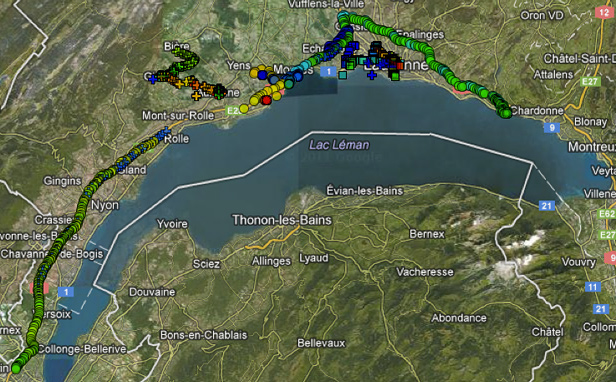A Phone that Knows Where You’re Going

Beyond merely tracking where you’ve been and where you are, your smartphone might soon actually know where you are going—in part by recording what your friends do.
Researchers in the U.K. have come up with an algorithm that follows your own mobility patterns and adjusts for anomalies by factoring in the patterns of people in your social group (defined as people who are mutual contacts on each other’s smartphones).
The method is remarkably accurate. In a study on 200 people willing to be tracked, the system was, on average, less than 20 meters off when it predicted where any given person would be 24 hours later. The average error was 1,000 meters when the same system tried to predict a person’s direction using only that person’s past movements and not also those of his friends, says Mirco Musolesi, a computer scientist at the University of Birmingham who led the study.
He cautions that the 200 participants might not reflect the general population—they all lived within 30 miles of Lausanne, Switzerland, and were mainly “students, researchers, and people that are fairly predictable anyway.” Even so, he says, the findings were noteworthy because “we are essentially exploiting the synchronized rhythm of the city” for greater predictive insights.
Although it is still a research prototype, the prediction algorithm, described in this paper, could be a boon to mobile network operators if it proves more widely applicable. These companies already possess such data and could use it to provide a sharper recommendations or ads for restaurants or shops near locations where you are likely to go. Musolesi’s group is planning to build a developer platform based on the algorithm.
This paper was part of a Nokia-sponsored Mobile Data Challenge, at which the Birmingham group won 3,000 euros for their work. Other papers from the contest can be found here. All the projects drew on the same smartphone dataset from the 200 volunteers, who agreed to have their location, communication patterns, app usage, and other metrics tracked over an 18-month period ending in 2011.
To explain how your friends’ patterns can be used to refine predictions about you, Musolesi gave an example. If Susan goes from home to the gym every Tuesday at 7 p.m. following a certain route, a prediction algorithm based only on her past movements might be thrown off on a certain Tuesday when she makes a side trip to the mall. But by noticing that her close friends Joe and Bob are in their usual hangouts that day, Musolesi’s algorithm can determine that Susan is highly likely to go to the gym after finishing her mall errand. Habits and patterns of friends are highly correlated, meaning there will be enough noise-free information from the friends’ mobility patterns to extrapolate from them. Naturally, the predictions can be refined even more when two people often spend time with each other, but such “mutual information” is not required for a friend’s information to be useful.

The research grew out of a mid-2000s reality mining project, also sponsored by Nokia, that sought to glean insights about social interactions from personal devices. That work took place before the current smartphone boom. “It is exciting to see the project flesh out some of the hints and preliminary results we’ve seen in our earlier projects. This field is really moving toward being practical,” said Alex “Sandy” Pentland, director of the MIT’s Human Interactions Lab, referring to all of the research done on the Lausanne data.
He added that progress in the field—together with the many commercial efforts that already extensively mine and leverage personal data—makes it even more crucial for companies, governments, and researchers to follow a personal data privacy and usage framework developed at Davos last year.
Keep Reading
Most Popular
Large language models can do jaw-dropping things. But nobody knows exactly why.
And that's a problem. Figuring it out is one of the biggest scientific puzzles of our time and a crucial step towards controlling more powerful future models.
The problem with plug-in hybrids? Their drivers.
Plug-in hybrids are often sold as a transition to EVs, but new data from Europe shows we’re still underestimating the emissions they produce.
Google DeepMind’s new generative model makes Super Mario–like games from scratch
Genie learns how to control games by watching hours and hours of video. It could help train next-gen robots too.
How scientists traced a mysterious covid case back to six toilets
When wastewater surveillance turns into a hunt for a single infected individual, the ethics get tricky.
Stay connected
Get the latest updates from
MIT Technology Review
Discover special offers, top stories, upcoming events, and more.